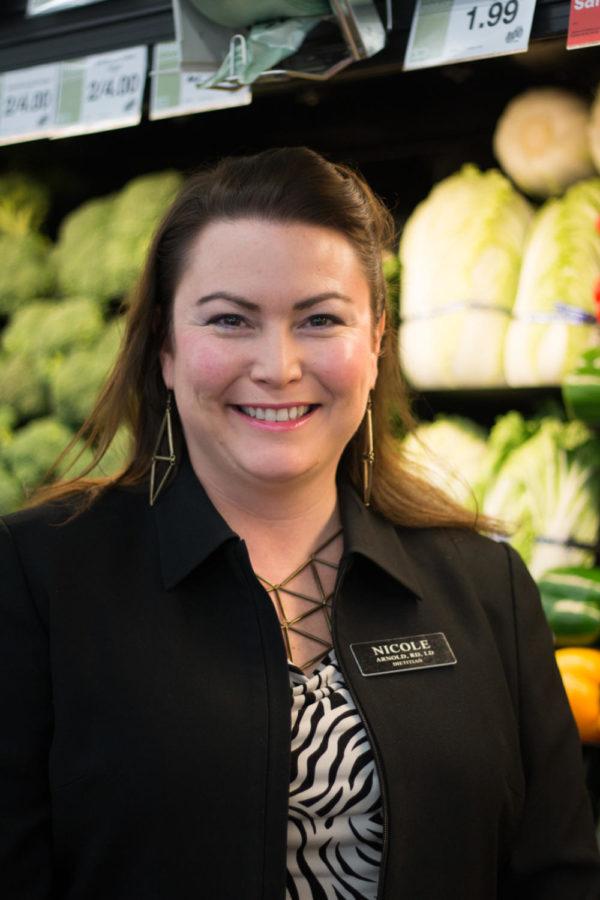Steer toward the healthy side
Nicole Arnold, a dietitian at the HyVee in West Ames, stands in front of the produce aisle. Arnold graduated from Michigan State University and has worked as a HyVee dietitian since April 2006.
January 27, 2016
The end of January can mean many things: another guaranteed month of being cooped up inside, winter comfort food to stave off the chill and either the continuation or cessation of the common New Year’s resolution to be healthier.
If you feel like you’ve fallen into a mid-winter slump, find some tips from local experts to make simple steps toward being healthier.
Homemade
The first tip offered those looking to make a change was to know what goes into their food by controlling the ingredients and making their favorite products from scratch.
Power bars, a popular item touted as health food, can be loaded with sugar and are expensive, Arnold said. Instead, make power bars.
It is really easy to just add protein powder with a base such as peanut butter and honey, she said. Just throw in some old cupboard snacks like raisins and nuts, or even add chocolate for a little treat.
Rose Martin, senior lecturer in food, science and human nutrition, said making homemade foods also allows for controlled portions.
For college students, pizza is a constant diet sabotage. Take a break from ordering pizza and make your own. Thin crust pizza is better than thick crust. Also when picking a pizza, the ones with vegetarian tend to be better than the ones loaded with meats. Eating a salad before chowing down on pizza can ensure that you get your vegetables and eat fewer slices.
Keep it colorful
Fruits and vegetables are important in maintaining a fresh diet. It is a good idea to create a colorful plate when making a meal. Keeping it colorful means to add things such as fruits and vegetables, spices and seasoning to the meal.
Different colors of produce correspond to different vitamins and minerals, Martin said.
“Keep it simple,” Arnold said when talking about how to spice up a meal.
Use simple things like strawberries lettuce, and green beans. Picking produce can sometimes be a challenge. The fruit or vegetable should have a little softness to it, but not too much.
Frozen vegetables are great to add to ramen noodles to make the meal more filling and nutritious, Arnold said.
In order to work more produce into your diet, you need to know how to shop for it. Arnold offered shopping tips for produce. Let produce ripen in a paper bag for a few days if you buy produce in bulk. Also, don’t ever buy produce with bruises on it. That could result in having to throw the entire purchase in the garbage.
When it comes to choosing between apples, apple sauce, and apple juice, just remember the less sugar added the better. Apples obviously should be your first choice because they have no added sugar to them. Always check the added sugars on the label.
It is healthier to choose original apple sauce and add your own ingredient to make it your own. Plus, there will be a lot less sugar, Arnold said. If you decide to drink apple juice, make sure to pay attention to the amount per serving and the added sugar. Juice is good to drink as long as it is in moderation.
Fiber vs. Sugar
Fiber is extremely important in the function of the digestive system.
“The goal is to go for three grams of fiber per serving,” Arnold said.
Sarah Haveman, certified diabetes educator at the Diabetes and Nutrition Education Center at Mary Greeley Medical Center, said fiber tends to help regulate glucose levels. Haveman said some foods, such as processed foods, have “fake fibers” but fresh fruit has real fiber so there should be some fruit on your dinner plate every night.
Martin also said fiber is good for the gastrointestinal tract because foods with insoluble fiber, such as vegetables, fruits and whole grains, help move bulk through the digestive system.
Next time instead of just grabbing some random bread and throwing it in the cart, turn it over and read the label. It is important to have more fiber and less sugar. Also when reading the ingredients list, check and see if the first ingredient is whole wheat. Whole grain is not the same as whole wheat.
“Stick to what is in nature,” Arnold said.
Inexpensive snacks
The grocery store is bursting with snacks more nutritious and less expensive than vending machine products, Martin said.
Humus is a good snack option because it comes already made, contains healthy fats and protein and tends to be fairly inexpensive. Vegetables and healthy crackers can be dipped in hummus.
Cheese with a low-fat content is also recommended for the protein and calcium content. The Laughing Cow cheese is a great low-calorie snack. Even though it is a little more expensive, it won’t hurt to splurge every once in a while.
“Wrap string cheese around deli meat for a good snack,” Arnold also recommended.
Martin said peanut butter and jelly can be one of the best snacks to have if the right whole wheat bread is chosen with a light layer of jelly.
The food plate
The United States Department of Agriculture has the Choose My Plate program to help guide American’s diets. The food plate provides guides for portion sizes and percentages of food groups that are recommended. The typical meal plate should contain 30 percent vegetables, 25 precent grains, 25 percent protein and 20 percent fruit.
Visit choosemyplate.gov for more tips.







